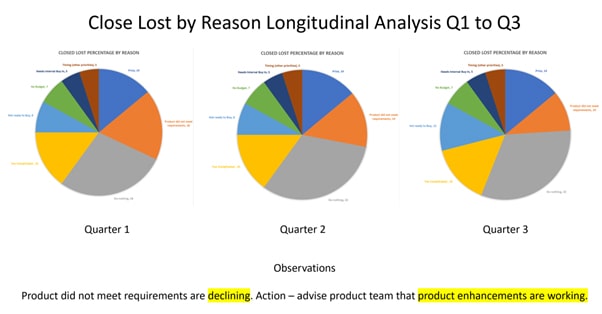
For anyone operating in the B2B SAAS market, you will know that Closed Lost Analysis is as important and Closed Won Analysis. There is however very strong resistance to examine why you lost a transaction, and curiously not much appetite in looking at why you won an Opportunity. Once the deals done, it’s very often onto the next Opportunity and if its Lost, much the same, move on to the next Opportunity.
What is Closed Lost Analysis?
Closed Lost Analysis is typically performed once an Opportunity has been deemed to be lost, i.e. the customer is no longer proceeding with your company.When and where is this process completed?
Closed Lost is a process where the Opportunity is officially Closed in your Customer Relationship Management (CRM) system, for example Salesforce. It is completed by the Business Development Manager (BDM) or Inside Sales Representative or via a Survey.Deep Dive – Closed Lost Analysis
So, you lost the customer somewhere along the journey 🙁 The critical reason to understand is Why? If companies conduct a Close Lost Analysis, this is what it typically looks like: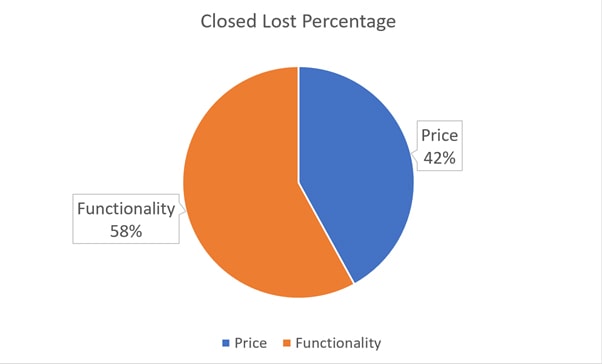
Makes logical sense, price and product functionality are two logical reasons to lose an Opportunity. In my experience, this is only 20% of the answer. The real reasons have not been identified and don’t give you much actionable data.
This is what it probably should look like:
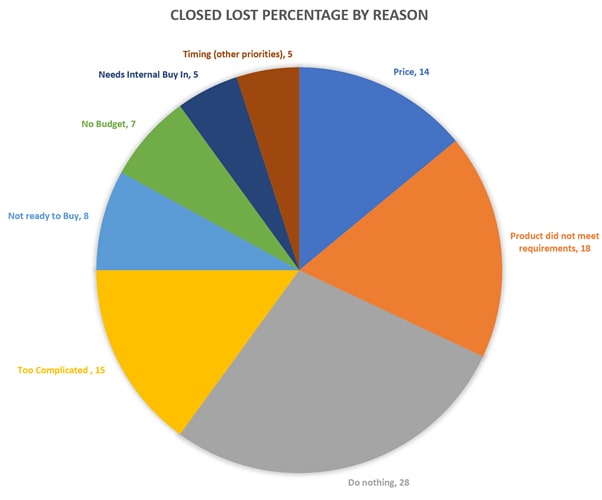
Lets look at each reason and solve for it:
Price
Price is always an issue but if this is a repetitive reoccurring theme, you probably have to look at your pricing strategy or at the market you are aiming at. Selling at Enterprise prices into the Small and Medium market often results in price mismatches.Product did not meet requirements
This happens, you can’t be all things to all people. However, you want to know why it did not meet requirements. For example, which part of the product was deficient? Why was it deficient. This data should then be fed back to the Product Management team for future development.Do Nothing
If the customer elects to do nothing, then you might have a qualification or need identification problem. The customer came to you with a need, often this need is not explored. If you know clearly what they are trying to fix and the problem is big enough, you should be able to help the customer build a business case. If the cost of the problem is larger than the cost of the solution, they should not Do Nothing.Too Complicated
This is a really interesting reason for Closed Lost. If the client perception is that the product is too complex, it probably means that the product was made (unintentionally) to look too complicated. This often results from a lack of knowing what the client is trying to fix, so the product demonstration covers every feature the product has, resulting in the client perceiving that the product is too complicated.Not Ready to Buy
This reason often relates to insufficient qualification of the customers needs. If the customer has a problem and your solution fixes it, then they should proceed with you or a competitor. If they don’t proceed, it often means that the the problem has not been quantified by the team working on the Opportunity.No Budget
If the customer has no budget, that’s fine, help them develop a budget. Again, if your solution helps them fix a real problem, then working with the customer to develop a solid budget is the best outcome for both of you. If its a timing of Budget allocation, for example, the customer is allocating Budget in the next financial/fiscal year, that fine, keep working with the customer to develop a Budget even if its for the next financial period.Needs internal socialization
If your solution is not a replacement solution, then its probable the customer will need to socialize the product with other stakeholders in the customers organization. That’s pretty normal. Best advice here is help the customer socialize the product, the products use case and the business problems it solves. Given you probably know more about the product and what it fixes than the customer, ideally work with the customer to socialize it with other internal customer stakeholders.Timing (other priorities)
This reason is sometimes hard to overcome as the customer may have other priorities at an organizational level that you may not be aware of and neither is your customer aware of. For example, your are working with you customer sponsor on a Learning project, they present the solution to the senior management team and get told that the Learning project ranks 4th in their priorities as they have other projects already in progress. Keep working with the customer until their organization places your solution at the top of the priorities list.Summary on Closed Lost by Reason
Every part of Closed Lost Analysis will tell you something. If you are operating at any scale, this data is very valuable to the organisation as it builds up over time, giving you clear visibility on what can be improved and what your priorities should be.Longitudinal Closed Lost Analysis by Reason
If you are conducting Closed Lost Analysis by reason for each transaction, moving it up a gear to Longitudinal Analysis is a very good idea. Ideally, do this every quarter. This is typically what it looks like: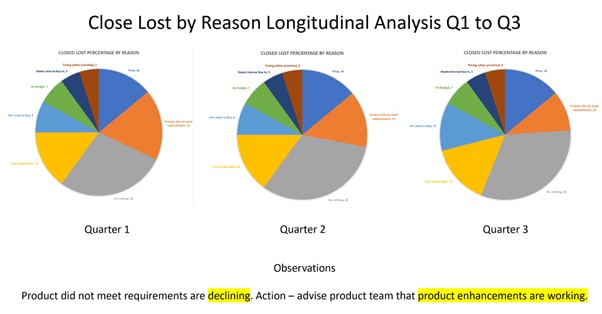
What you are looking for here is movements in the reasons why Opportunities were Close Lost. In the above example, it looks like Close Lost Product did not meet functional requirements are declining, therefor product are reducing the functional deficits in the product.
Longitudinal Closed Lost Analysis by Person
I would highly recommend conducting a Close Lost Analysis by person as well. This will give you insights into personal development for individuals where there are clear gaps. For example, if a Business Development team has an average of Too Complicated running at 15%, however one individual in the team is running at 40%, you have a skills deficit that needs to be fixed.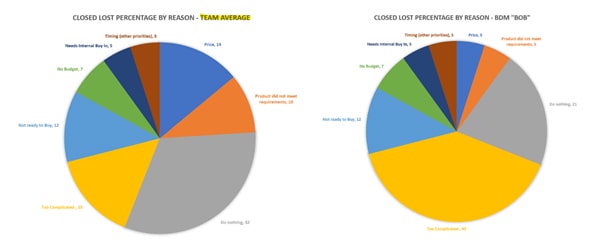
Closed Lost Data Input – how should it be done?
When entering Closed Lost data into your CRM system, often the person who managed the Opportunity is not the best person to input the data. The sales person may have a different perception as to what happened than what actually happened. Best Practice here is to use another resource to check in with the customer. Get an Inside Sales person to circle back with the customer and check what actually happened. This way you will get more accurate data and real customer feedback that you can apply to improving you product, customer facing teams, pricing strategy and more. Interestingly enough this Check In process, if conducted in an open conversational way, yields leads that often close once objections have been understood. It a second chance to get it right.Summary
Is you are not conducting Closed Lost Analysis, you are missing out on fundamental insights into your organisation. If you are conducting Closed Lost Analysis by Reason, move to Longitudinal (ideally quarterly) reviews. If you believe you have people issues, conduct Closed Lost Analysis by person.Help a SAAS Buddy
Comment on your experiences and Help Out a SAAS buddy today 😊
Author: Lyle Potgieter, www.SAAS-Know-How.com

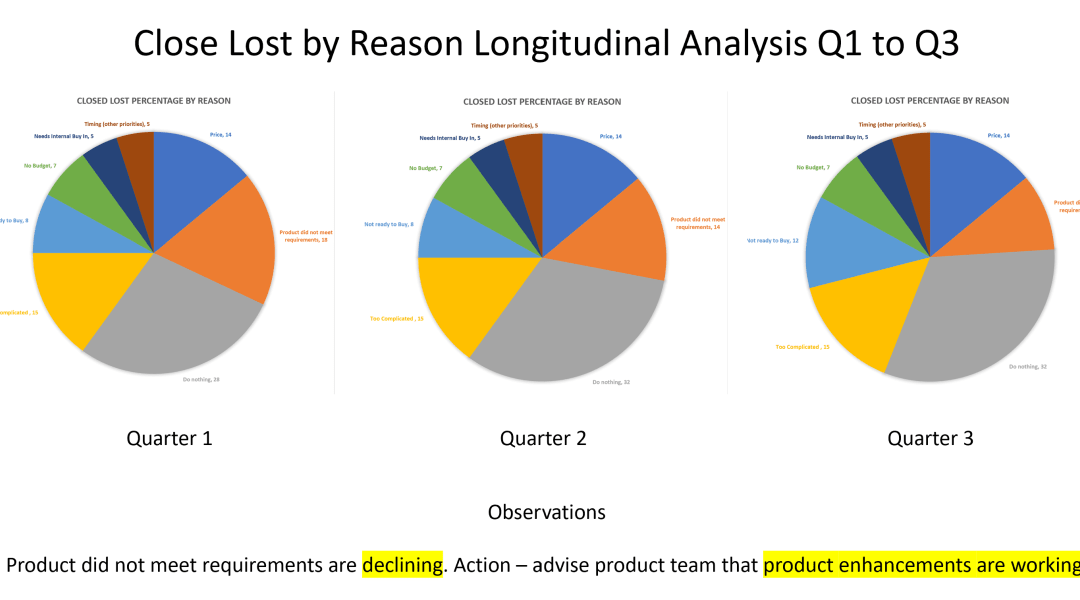
Yeah, Closed Lost never looked at, guys just move on to new deals, dont look at wrecked deals they could have won if they did a better job
I’m really loving the theme/design of your website.
Do you ever run into any web browser compatibility issues?
A couple of my blog audience have complained about my blog not operating correctly in Explorer but looks great in Firefox.
Do you have any tips to help fix this problem?
my web-site Buy CBD
Hey Tod, site works fine in all browsers. Best Lyle